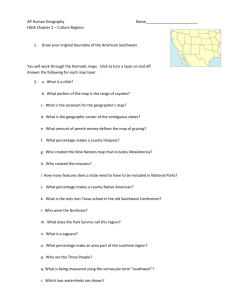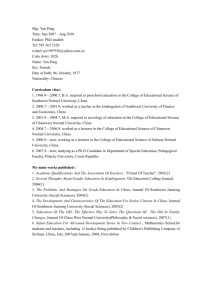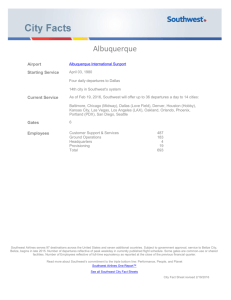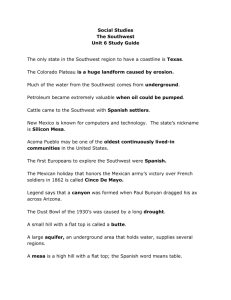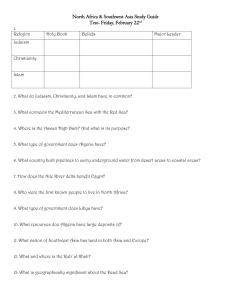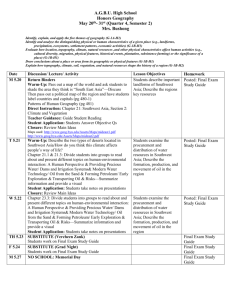Module #4 - Integrity Works
advertisement
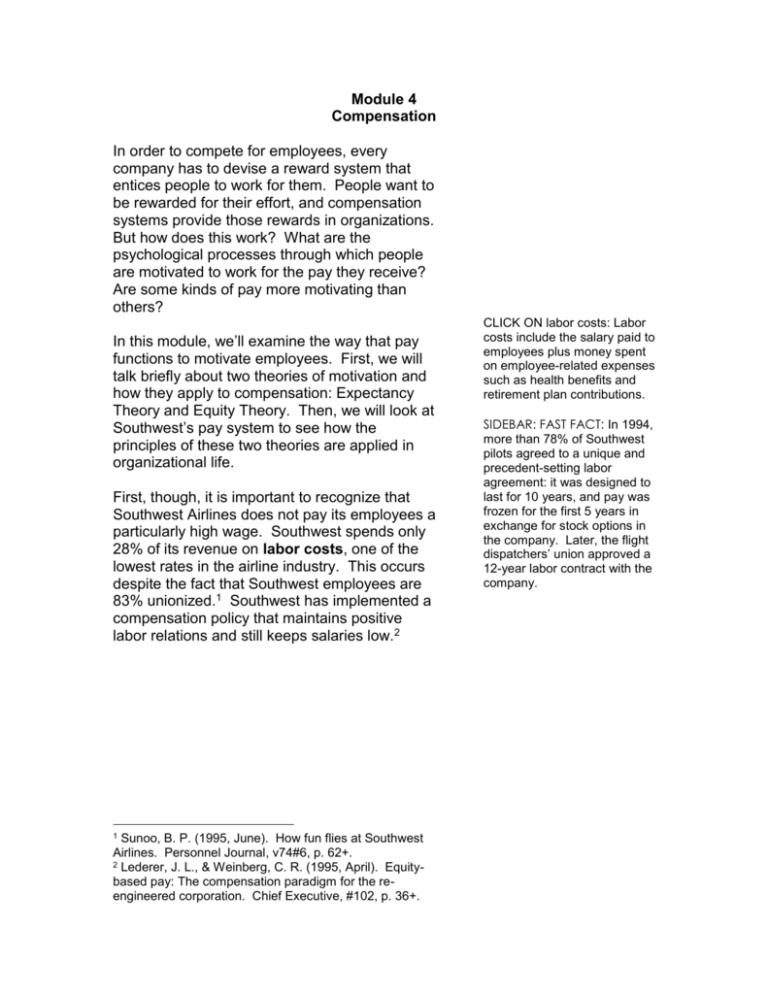
Module 4 Compensation In order to compete for employees, every company has to devise a reward system that entices people to work for them. People want to be rewarded for their effort, and compensation systems provide those rewards in organizations. But how does this work? What are the psychological processes through which people are motivated to work for the pay they receive? Are some kinds of pay more motivating than others? In this module, we’ll examine the way that pay functions to motivate employees. First, we will talk briefly about two theories of motivation and how they apply to compensation: Expectancy Theory and Equity Theory. Then, we will look at Southwest’s pay system to see how the principles of these two theories are applied in organizational life. First, though, it is important to recognize that Southwest Airlines does not pay its employees a particularly high wage. Southwest spends only 28% of its revenue on labor costs, one of the lowest rates in the airline industry. This occurs despite the fact that Southwest employees are 83% unionized.1 Southwest has implemented a compensation policy that maintains positive labor relations and still keeps salaries low.2 1 Sunoo, B. P. (1995, June). How fun flies at Southwest Airlines. Personnel Journal, v74#6, p. 62+. 2 Lederer, J. L., & Weinberg, C. R. (1995, April). Equitybased pay: The compensation paradigm for the reengineered corporation. Chief Executive, #102, p. 36+. CLICK ON labor costs: Labor costs include the salary paid to employees plus money spent on employee-related expenses such as health benefits and retirement plan contributions. SIDEBAR: FAST FACT: In 1994, more than 78% of Southwest pilots agreed to a unique and precedent-setting labor agreement: it was designed to last for 10 years, and pay was frozen for the first 5 years in exchange for stock options in the company. Later, the flight dispatchers’ union approved a 12-year labor contract with the company. Expectancy Theory To understand the concept of motivation, let’s begin with a fundamental question: why do people work? The answer is that they believe they will get both intrinsic and extrinsic rewards for their effort. Victor Vroom’s Expectancy Theory shows us how this psychological process works.3 Expectancy Theory states that people do certain things because they believe that their effort will result in an outcome and that they will be rewarded for that outcome. As the graphic illustrates, three criteria need to be met before someone is motivated to act. These are: 1-Effort leads to Performance: Expectancy. People first have to believe that their effort will produce a result. In some instances, simply working hard is enough to produce the desired result. On the other hand, if people lack a particular skill or don’t have the required equipment to complete a task, they will not be motivated to put forth much effort because they know they won’t accomplish much. 2-Performance leads to Reward: Instrumentality. Once people know that they can perform a task, what motivates them to do so? The answer is that they believe that their performance will be rewarded in some way. They see their performance as instrumental to obtaining a reward. The challenge for managers is to define performance expectations carefully so employees know exactly what behaviors will lead to rewards. Wherever possible, performance appraisal systems should include a description of the actual behaviors that 3 Vroom, V. H. (1964). Work and motivation. New York: Wiley. GRAPHIC: ATTACHED constitute excellent and poor performance. Then, the company’s compensation system should reward the top performers routinely so workers see the link between performance and rewards. 3-Attractiveness of the Reward: Valence. Even if workers believe they can perform a task, and believe that they will be rewarded if they do so, they are not likely to exert effort if the reward is unattractive to them. An additional challenge for employers is to devise a reward system that meets the individual goals and needs of most workers. The most common outcomes offered are salary and fringe benefits, such as medical insurance and retirement plans. Other rewards might be found in relationships developed on the job or feeling good about the work that is done. It makes sense that people would seek jobs that provide the kind of rewards they value most. For example, someone whose top priority is a high salary might join a company that does not provide health insurance if that person received a higher rate of pay. Logically, then, companies would tend to attract, hire and retain people who valued similar things. Recent research confirms that employees within a single company have remarkably similar values and needs, and that their similarity may increase the longer they stay with the organization. Because of this, companies will tend to attract, hire and retain new employees who are fundamentally similar to their current personnel.4 People who share basic values and desires are likely to find the same kinds of rewards attractive, and consequently, motivating. Equity Theory One of the most important ways that people evaluate the valence, or attractiveness, of the 4 Schneider, B., Goldstein, H. W., & Smith, D. B. (1995). The ASA framework: An update. Personnel Psychology, 48, 747-773. SIDEBAR: One way that Southwest tries to recognize the individual needs of their workers is through its flexible benefit plan. Under this plan, employees are given a set amount of money that the company will spend on their benefits each year. They can choose to allocate that money toward whatever benefit programs they prefer, choosing between various types of medical and dental insurance, life insurance, and similar programs. However, all employees enjoy one of the most popular benefits the company offers: free flights on Southwest Airlines for themselves and their families. rewards they receive is by measuring their pay against the effort they expended. The underlying premise of Equity Theory is deceptively simple: people want fair treatment. Specifically, J. Stacey Adams’5 version of Equity Theory says that people actively evaluate the ratio between the amount of effort they put into a situation and what they get out of it. In the work environment, this means that they determine the relationship between how hard they work and how much they are paid. They then compare their ratio to that of “referent others,” or other people who are important to them. If people believe that their ratio of inputs (work) to outputs (pay) is the same as referent others’, then a state of equity exists and the arrangement is judged as fair and equitable for the employee. These comparisons can result in three different perceptions: equity, under-rewarded inequity, or over-rewarded inequity. In the first situation, equity, the ratios are judged to be similar and the overall sense of the work arrangement is that it is fair. On the other hand, should you believe that someone is doing less work and receiving more pay than you are, you would experience inequity and see yourself as underrewarded. Your most likely emotional response to this situation would be frustration or anger. Finally, if you think that someone else works harder than you do and yet receives less pay, you would also experience inequity but see yourself as over-rewarded. Here, the likely emotional result is guilt. How do people respond to inequity? Regardless of people's exact emotional response to feelings of inequity, research demonstrates that they are usually motivated to change situations that they view as unfair. Those who feel that they are overpaid relative to 5 Adams, J. S. (1965). Inequity in social exchange. In L. Berkowitz (Ed.), Advances in experimental social psychology (Vol. 2, pp. 267-299). New York: Academic Press. SIDEBAR: People can choose to compare themselves with a number of other people to make equity judgments. The choice of a referent other is personal, and depends on who the individual thinks is the most important source of comparison. In making equity judgments, you might choose to compare your work input and salary output to people in your work group, to others in your class, or perhaps to members of your family. As you can imagine, the choice of a referent other for comparison is critical. You might get very different results if you compared your work input and salary output to someone your own age or a CEO of a large company. other people may choose to work harder, providing more input for the same amount of compensation. Those who feel underpaid may choose to work less, thereby putting in less effort for the same output. It is also likely that people who perceive inequity would simply adjust their mental state by picking another referent other for comparison. What should employers do to be fair? Research based on Equity Theory suggests some practical tips for employers who want to design an effective compensation system:6 1. When people are paid for the amount of time that they work (vs. payment for the amount they produce), they will work harder when they are overpaid. As we noted, people who perceive overpayment inequity may feel guilt, prompting them to increase their inputs to make the input/wage ratio more even. However, when people are paid for the amount of time that they work and perceive that they are underpaid, they will work less hard and produce less output. 2. When people are paid based on the amount they produce, over-rewarded employees will produce fewer products, but they will be of higher quality. On the other hand, when people in this pay system are underrewarded, they will produce more goods but of lower quality. In this way, they can get more output (pay) from the organization because they made more products, but they haven’t had to work that hard to make them so their inputs have been reduced. SIDEBAR: Research demonstrates that people who perceive pay inequities are more likely to steal from their employers. For example, in one study employees in a manufacturing plant were asked to take a temporary pay cut for 10 weeks. During that time, employee theft of company property increased dramatically. Once salaries were returned to their pre-cut level, theft rates declined to their normal level.7 SIDEBAR: Ironically, Southwest’s “pay for seniority” system violates this principle. For example, in their system two baggage loaders who work side by side on the runway might make significantly different hourly wages if one has been with the company longer than the other. It may be that Southwest’s culture offers other rewards for new employees that compensate for their relatively low pay. Despite what Equity Theory tells us, people put up with wage disparities at Southwest. Why do you think this might be the case? 3. Treat employees equally wherever possible. If people are doing the same work, they should receive the same pay. 7 6 Goodman, P. S., & Friedman, A. (1971, September). An examination of Adams’ theory of inequity. Administrative Science Quarterly, 271-288. Greenberg, J. (1990). Employee theft as a reaction to underpayment inequity: The hidden cost of pay cuts. Journal of Applied Psychology, 75, 561-658. Pay at Southwest: Expectancy and Equity Theories at Work First, to see how an effective reward system works through the Expectancy Theory lens, let’s examine Southwest’s incentive program for its Field and Product Marketing Division. Like all Southwest employees, everyone who joins this division receives extensive training. Recruits are carefully evaluated to make sure they have what it takes to do the job they’re hired for, and once they are on the job workers are given the autonomy and freedom to complete their work as best they can. So the first stage of the Expectancy Theory model is met: people believe that their effort will result in performance because they are given the skills and tools necessary to do their jobs. SIDEBAR: The hallways of Southwests’ offices are filled with photographs of employees doing their job, receiving awards, and engaged in various company activities. Kelleher says, “Those pictures show that we’re interested not in potted palms or in Chinese art, but in our people. It’s another kind of celebration, and it’s something that costs very little.”8 But exactly what performance should they display? In other companies, marketing and sales-oriented departments are compensated on the basis of individual sales goals: people receive a commission, or percentage of each sale, to reward them for completing it. This practice effectively motivates people to complete sales transactions. However, it has a downside. People may focus on completing sales to the exclusion of other marketing-related activities that also benefit the company. These systems also tend to promote competition among workers because they are rewarded individually for performance. Neither of these are desirable performance outcomes for Southwest Airlines. So, the company has designed a compensation system that rewards the behaviors they believe are most important in their marketing department. Employees receive “bonus points” for a variety of activities that include, but are not limited to, completing sales. These might include taking the time to set up special events for frequent fliers or helping develop new advertising campaigns. Second, though Southwest’s marketing employees earn points individually, the entire sales district must qualify 8 Gruner, S. (1998, May). Have fun, make money. Inc., v20# 6, p. 123+. for an award before any one individual receives additional compensation. So, rather than promoting competition, the system rewards performance based on teamwork and cooperation. Because this framework is clearly and consistently communicated to employees, the second step in Expectancy Theory is met: people understand what performance will lead to which rewards. Finally, we have to ask if the rewards have positive valence for employees. Do they like what they receive? Is it fair? If the answer can be found in terms of job satisfaction and high performance, the answer certainly is a resounding yes. Southwest has found one of the important benefits of equity-based compensation plans that reward all members of the team equally: they align the interests of companies, shareholders, and employees so that everyone works together toward a common goal. SIDEBAR: Paychecks at Southwest are signed, “From Our Customers.” As Kelleher puts it, “The check doesn’t come from a piece of corporate paper called Southwest Airlines...it comes from the people that we deal with every day, our passengers, and they’re the ones that supply the wherewithal for our employees’ livelihood.”9 Equity on a Grand Scale: Profit Sharing at Southwest On a larger scale, Southwest’s profit-sharing plan also contributes to a feeling of teamwork and company loyalty among its personnel. Southwest started the airline industry’s first profit-sharing plan in 1974, and because the company has made a profit each year, employees reap the benefits in terms of additional compensation. Each person receives the same percentage of their base compensation as a salary bonus every year that the company makes money. In 1998, Southwest employees received an additional 13% of their pay through this program. The profit sharing plan makes the profitability of the entire company important to each individual employee. And, because the percentage awarded is the same for everyone, the system is perceived to be equitable and fair. SIDEBAR: Companies like Southwest that have a significant amount of employee ownership tend to outperform their industry peers.10 9 Kelleher, H. (1998, May/June). Customer service: It starts at home. The Secured Lender, v54n3, pp. 68-73. 10 Lederer, J. L. & Weinberg, C. R. (1995, April). Equitybased pay: The compensation paradigm for the reengineered corporation. Chief Executive, #102, p. 36+. Additionally, we cannot overlook the importance of non-monetary compensation at Southwest. As we’ve already established, people tend to join Southwest for reasons other than money. The compensation system is just one more tool in Southwest’s management arsenal for motivating employees to work hard and well for the airline. SIDEBAR: People who work for Southwest Airlines may not enjoy high salaries, but they do receive rewards that they value as much if not more. As one of their middle managers put it, “The reason most people are working here is not monetary or material. Culturally, having a working atmosphere that is fun and flexible is what motivates us most.”11 11 Hein, K. (1999, January). Rewarding relationships. Incentive, v173#1, p. 114.
